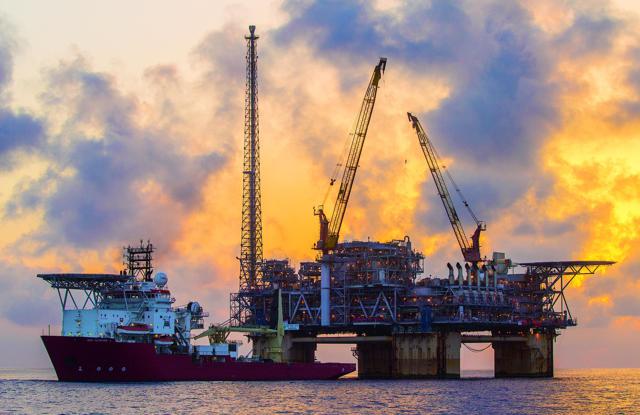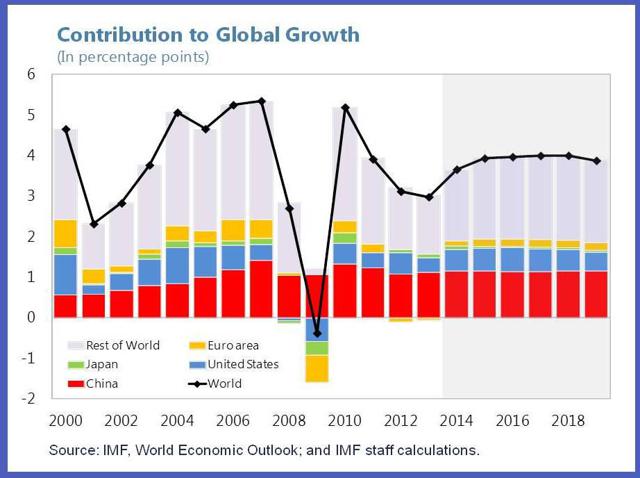Summary
- The Peak Oil theory sure turned out to be wrong. Drilling technology changed.
- The conventional wisdom about future oil demand is also wrong.
- The demand for—and supply of—transportation is the big game-changer.
- Transportation accounts for almost 75% of oil use in the U.S. and higher MPG is only a part of the solution.
- Technology is changing the number of trips we’ll take and how we’ll travel.
Peak Oil
"Peak oil" is a theory that refers to a point in time when the maximum rate of extraction of petroleum is reached. Once it is reached, the rate of production enters terminal decline.
That is how it was supposed to happen anyway, according to M. King Hubbert, a geologist for Shell Oil (NYSE:RDS.A) (NYSE:RDS.B). Back in 1956, he predicted that U.S. oil production would likely peak between 1965 and 1970 and decline steadily thereafter. U.S. oil output did peak at 9.6 million barrels per day (mmbd) in 1970 and began its long decline-with an interim boost when Alaska came on-line. But because of the oil shale revolution, U.S. oil production recently hit 9.6 mmbd again.
The lesson here is that technology changed everything. Hubbert was assuming the oil field development technology of his era when crude oil prices were less than 7 cents a gallon ($2.80 per barrel).
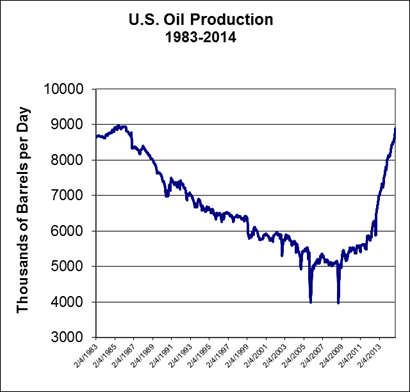
Data Source: Energy Information Administration
Peak Demand
U.S. oil use became almost 75% transportation-related, and so the demand for and supply of transportation is key to predicting oil use. About ten years ago, consumption began to drop in the industrialized world. At first, it was attributed to the rise in crude prices. Then the financial crisis of 2008/09 caused oil use to drop.
By now, the world economy has recovered for a few years.
However, OECD oil consumption, which includes the U.S., European Union and Japan, peaked in 2005. However, in 2014, oil consumption fell by 1.2% and is back to its 1995 levels.
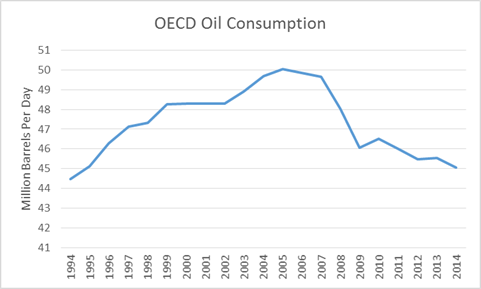
Data Source: BP Statistical Review.
In the European Union, peak oil consumption occurred in 1979. That's when oil prices spiked due to the Iranian Revolution followed by the Iran-Iraq war. OPEC subsequently kept prices high but cutting back output but Saudi Arabia capitulated in late 1985 after the call on its oil dropped below 3 mmbd.
Consumption did rise again in the low price era but peaked out again in 2006. Oil use fell by 1.2% in 2014 and was at its lowest level since 1985.
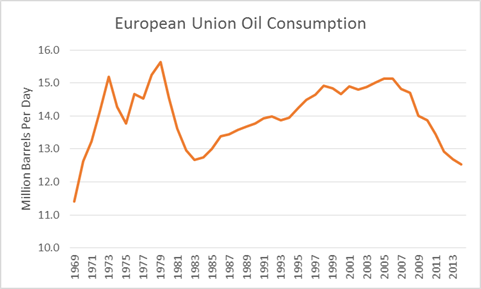
Data Source: BP Statistical Review.
Oil consumption in Japan peaked almost 20 years ago in 1996. In 2014, oil use dropped 5.2 % and was back to where it was 45 years ago in 1971.
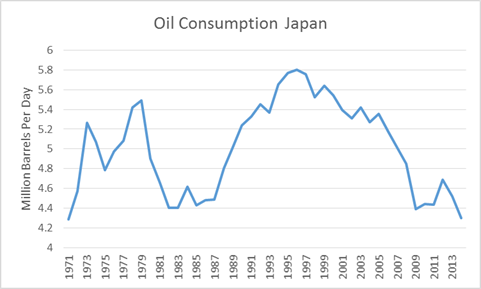
Data Source: BP Statistical Review.
In the United States, peak consumption occurred in 2005. In 2014, oil use gained 0.5%.
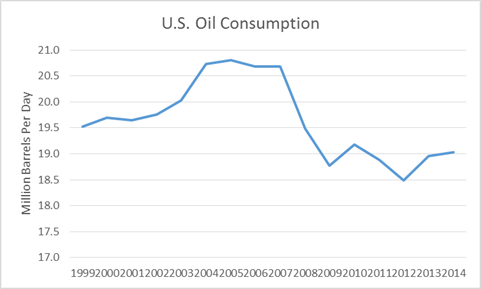
Data Source: BP Statistical Review.
World oil consumption is only rising because of gains in the emerging nations. China accounts for the largest portion of new growth. But in 2014, its growth pace of 3.3% is well below the 10-year average of 5.1 %.
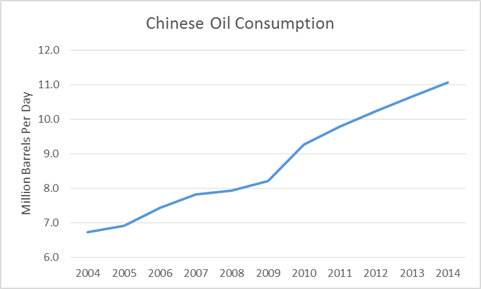
Data Source: BP Statistical Review.
"Beam Me Up, Scotty"
The conventional wisdom has been that the demand for cars will increase with population growth worldwide. In 2010, Americans scrapped 4 million more cars and trucks than they purchased, the first significant drop in the U.S. auto fleet in more than four decades.
Among the reasons cited by Lester Brown of the Earth Policy Institute is a shift away from the importance and prestige of the automobile in the youth culture. "Perhaps the most fundamental social trend affecting the future of the automobile is the declining interest in cars among young people," Brown said. "Many of today's young people living in a more urban society learn to live without cars. They socialize on the Internet and on smartphones, not in cars." Car fleets are plateauing or have begun to shrink in most major car markets, including the U.S., Europe and Japan.
Internet services such as Skype, for example, the free video chat and voice calls service, has exploded, and it's still in its infancy. In 2013, Skype-to-Skype traffic was 40% the size of the entire telecom market.
Skype is reducing the travel previously needed for face-to-face meetings of all sorts. For example, it may be just as good as being there in person for delivering therapy.
"Conducting behavioral family systems therapy for diabetes with teens with poorly controlled diabetes either face to face in the clinic or using videoconferencing with Skype appears to result in similar improvements in both adherence to the diabetes treatment regimen and glycemic control," commented first author Michael Harris, PhD, a professor and director of Novel Interventions in Children's Healthcare at Oregon Health & Science University in Portland.
About 17% of adults on the internet use Skype. There are 100 million Skype users in China.
Uberization and Autonomous Cars
If you still need to drive to your meetings, the choices have evolved. UBS predicts that by 2020 battery costs will be slashed in half, making electric cars the most economical choice. Transportation will move away from oil as electric vehicle fleets expand rapidly and are replaced by bike-and-car sharing.
Ride-sharing is already popular in many cities and is a much more economical way to get around a city than buying and owning a car if one doesn't drive more than 10,000 miles a year. And a UC-Berkeley study showed that vehicle ownership among car sharing users was cut in half. If a person is paying for every trip vs. just the gasoline price, they will be more deliberate about which trips to take, thereby becoming more efficient.
Uber (Pending:UBER) claims that it is "committed to changing people's lives by revolutionizing urban transportation" by reducing the number of cars in cities, making them more livable. That's based on Uber being a cheaper alternative than owning a car.
Cities currently account for about 66% of global energy use, with forecasters projecting that figure to rise to 80% as the population shifts to urban centers. But this trend of massive urbanization will more likely reduce the viability of private car ownership in the very places that are supposed to serve as the new centers of oil use, such as India, Indonesia and the Arab Gulf.
Car-sharing services such as Uber intend to change transportation in urban areas. Riders simply request rides on a phone app and payment is made through the credit card associated with the account. Uber has more than 20,000 drivers in Los Angeles, its largest market. The wait time to be picked up is usually less than 5 minutes.
Uber has aspired to take a million cars off the roads of London, despite the inevitable increase in the city's population over the coming years. Uber has recently launched a service called UberPool, which picks up passengers headed in the same direction, dropping each off along the way. This makes the service extremely efficient for the driver, thus enabling Uber to reduce costs to passengers even further. The point is that the service will dramatically reduce miles driven per year and Uber claims it's saved 674,000 miles of driving in the few cities where it's offered since last year. The companies offering on-demand carpooling believe it is transforming mass transportation.
Uber has also introduced a service in some markets called UberFresh. It delivers meals from restaurants so people don't need to drive there and back. This type of service will reduce the amount of driving done for such errands.
Uber serves 290 cities worldwide and has over 8 million users. More than 55% of U.S. cities has access to an Uber car. Uber revealed that there were now 14,088 registered Uber cars, compared to 13,587 of the yellow cabs that have long been ubiquitous in New York City.
Uber managed 140 million rides in 2014 and is managing one million rides daily. Uber is now available in parts of Central and South America, such as Barranquilla, Santiago and Rio de Janeiro. It has extended its reach throughout Europe, the Middle East and Africa. If you are in Abu Dhabi, Athens, Brussels, Krakow, or Prague you can get can signal Uber on your cell phone and get picked up. In the Asia-Pacific region, it's available in Adelaide, Tokyo, Singapore and Kuala Lumpur. It operates in 11 cities in India. It cannot operate in China yet, but two car-sharing services there have merged to serve Chinese cities.
Uber pays about 75% of its revenues to its drivers who it considers to be independent contractors. It would like to replace them with autonomous cars.
The transition to autonomous cars is further along than most people may realize. Elon Musk says that Tesla Motors' (NASDAQ:TSLA) 2015 models will be able to self-drive 90 percent of the time.
GM's 2017 models reportedly will feature "technology that takes control of steering, acceleration and braking at highway speeds of 70 miles per hour or in stop-and-go congested traffic." Both Google (NASDAQ:GOOG) (NASDAQ:GOOGL) and Tesla predict that fully-autonomous cars will be available to the public by 2020.
Autonomous cars have the potential to revolutionize auto transportation with the Uber system. Instead of private ownership in urban areas, Uber can have them picking up and dropping off people continuously, resulting in greatly reduced miles driver per person. PricewaterhouseCoopers predicts that the number of vehicles on the road will be reduced by 99%, estimating that the fleet will fall from 245 million to just 2.4 million vehicles. While that statement appears to be a great exaggeration of the effect, a very substantial reduction in cars and miles traveled to perform errands seems very likely. (Read Zack Canter's "How Uber's Autonomous Cars Will Reshape the Economy by 2025").
Conclusions
The worry for decades has been that the world would be running out of oil before suitable alternative energy sources could be available for a reasonable price based on the Peak Oil theory. The shale oil revolution has changed that. OPEC is now competing to regain its market share by foregoing as much as $500 billion in revenues this year.
Unlike conventional wisdom, oil demand is likely to peak due to technology changes in the demand and supply of auto transportation. Because of internet services such as Skype, we won't have to travel physically to as many meetings. With the expansion of electric cars, car-and-bike sharing services like Uber, and the development of autonomous cars, the supply of transportation in cities will become far more efficient, and that will bring down auto miles driven using oil substantially.
Because transportation is the largest component of oil use, the global demand for oil will be dropping in the not-too-distant future, just as it has in the OECD countries.



